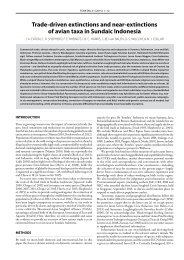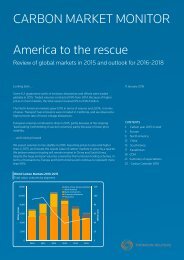Emissions Trading Worldwide
1TbjEHd
1TbjEHd
Create successful ePaper yourself
Turn your PDF publications into a flip-book with our unique Google optimized e-Paper software.
Meanwhile, during the first phase (2015 – 2017) the cap has<br />
been fixed at approximately 1,687 million Korean Allowance<br />
Units (KAUs). The cap includes allowances allocated to indirect<br />
emissions. Allocation may be made according to historic GHG<br />
emissions (Grandfathering), historic activities (Benchmarking)<br />
or expected emissions from new and additional facilities. The<br />
method is chosen based on the allocation application written and<br />
submitted by each entity. A working group comprised of non-government<br />
experts from academia and the private sector decides on<br />
the allocation method based on the allocation application, and<br />
then submits its decision to the responsible authority. Allowances<br />
are finally allocated after consultation with the involved ministries<br />
and a review by the Allocation Decision Deliberation Committee.<br />
The procedure for verifying emissions is similar to that of other systems<br />
in that emissions are confirmed by a third party verifier that<br />
looks into GHGs emitted from production activities for one year.<br />
“The ‘Stakeholder Dialogues’ undertaken<br />
during the preparation phase of the<br />
KETS have been developed into the ‘ETS<br />
Consultative Body’, with greater scope<br />
to engage and communicate with stakeholders.”<br />
Operational status<br />
<strong>Emissions</strong> trading began on 12 January 2015 with the opening of<br />
the Korea Exchange (KRX). As of December 2015, the total trading<br />
volume was about 4.4 million tons (transaction value of 41 million<br />
USD), including KAUs, Korean Credit Units (KCUs) and Korean<br />
Offset Credits (KOCs). The trading volume of KAUs has been relatively<br />
low, and less than that of KCUs. However, the trading of<br />
KCUs has continued to rise since they were first listed on 6 April<br />
2015. Companies argue that the low level of transactions indicates<br />
that the KETS is poorly operated. However, this argument stems<br />
from a misunderstanding of the scheme per se. The main purpose<br />
of the scheme is not to facilitate emissions trading, but to achieve<br />
GHG reductions in a cost effective manner. Active trading is simply<br />
a result of the scheme’s operation. Furthermore, the KETS is a<br />
closed market, with limited participation from financial investors<br />
until at least 2020. Therefore, there is still little trade in derivatives<br />
with allowances as underlying assets. This differs from the EU ETS<br />
carbon market, for instance, in which derivatives, including futures,<br />
make up the majority of trades. Companies also assert that meager<br />
allocation has caused the low trading volume. However, more allocation<br />
does not necessarily lead to more trading. On the contrary,<br />
if the market comprised only companies intending to sell surplus<br />
allowances, then trading would not take place at all. Indeed, the<br />
most extreme measure to stimulate trading would be to allocate<br />
allowances disproportionately, and then let market forces find the<br />
balance. However, this is without a doubt an unreasonable and<br />
unfair approach to allocation.<br />
Already during the planning phase, companies argued that<br />
allocation levels were insufficient. Of course, if companies were<br />
to be allocated as many allowances as they requested, then the<br />
scheme would not drive any emissions reductions. In fact, it is still<br />
too early to tell whether allocation levels are either insufficient<br />
or excessive. So far, arguments are based on estimations rather<br />
than actual emissions levels and hence it would be reasonable to<br />
wait until emissions are first measured in May 2016 before making<br />
any conclusions. Here we can learn from the first phase of the EU<br />
ETS: In the first year of trading, companies’ anxiety about insufficient<br />
allowances drove up the allowance price, which then plummeted<br />
in the following year when actual emissions were measured<br />
and announced. Despite the initial fears, allowances were then<br />
deemed to be excessively allocated.<br />
The road ahead<br />
With the implementation of the KETS now well underway, the<br />
scheme will continue to develop and evolve, with several measures<br />
planned to support this process. Firstly, it is expected that<br />
companies will begin to invest in an increasing number of offset<br />
projects, thereby achieving emissions reductions in a diverse and<br />
flexible manner. In addition, there is a plan to establish a market<br />
monitoring system to provide companies with market information<br />
on a regular basis while monitoring unfair trade. Furthermore, the<br />
‘Stakeholder Dialogues’ undertaken during the preparation phase<br />
of the KETS have been developed into the ‘ETS Consultative Body’,<br />
with greater scope to engage and communicate with stakeholders.<br />
This new institution will encourage the participation of companies<br />
not able to take part in previous dialogues, and ensure that<br />
a range of opinions in the field are heard.<br />
According to analysis conducted by Korea’s leading economic<br />
research institutes 6 focusing on energy or climate change, the<br />
KETS will reduce mitigation costs by 44% – 68% compared to the<br />
TMS. Moreover, companies will have an incentive to invest in lowcarbon<br />
technology, such as renewable and highly efficient energy<br />
systems, and be encouraged to innovate. In the long term, these<br />
investments will contribute to economic growth and help Korea<br />
shift to a low-carbon economy. Yet, any such contribution can only<br />
be realized if operational factors supporting the KETS are designed<br />
reasonably. It would, however, be more than challenging to design<br />
an ideal scheme from the very beginning. Rather, it is believed that<br />
as the KETS continues to operate, over time we can achieve the<br />
gradual improvement and advancement of the scheme in line<br />
with local circumstances.<br />
international carbon action partnership<br />
19




